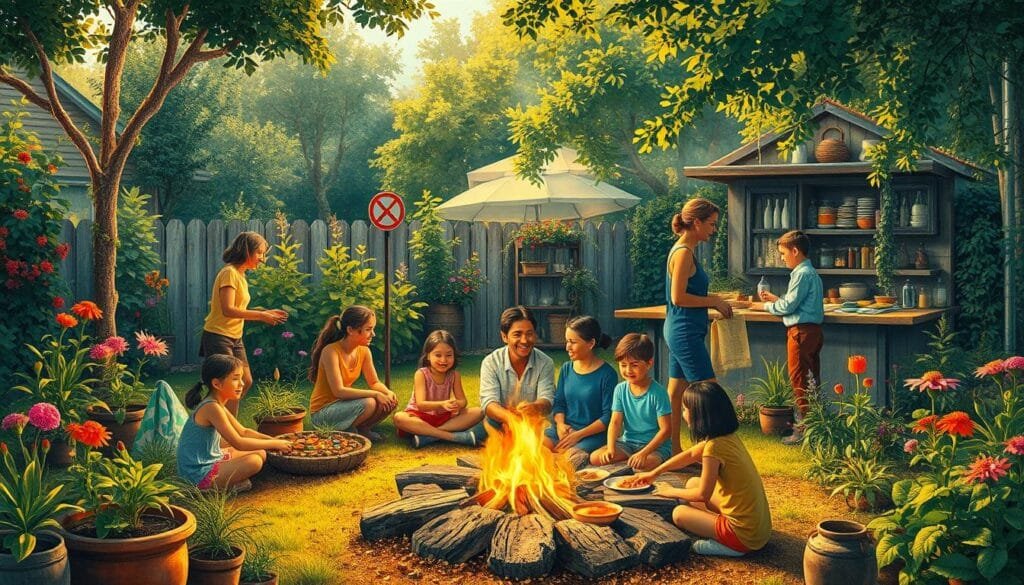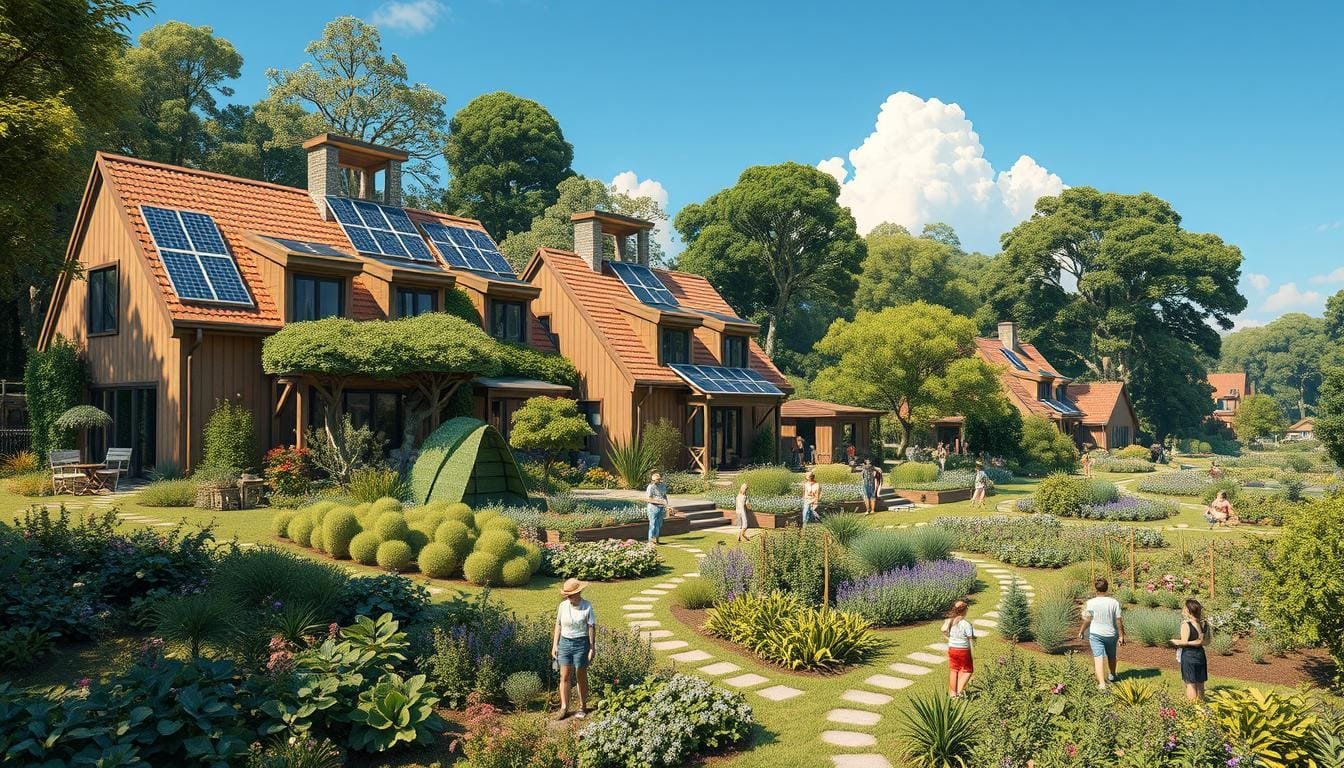Are we truly using the strength of various cultures to make our communities better?
In today’s world, the usual way of finding a home gets a lot of criticism. Intentional communities offer a great alternative. These places focus on shared values and working together. They highlight the benefits of living together that are more than just saving money. They aim to create a warm, supportive space where everyone can feel at home.
Recent studies have shown something interesting. If a community has a clear shared goal, its engagement can increase by 30%. A strong community spirit can also keep members around 25% longer. This shows how a community that knows its culture can do better for its people and stand strong together.
Key Takeaways
- Intentional communities are an option against the standard housing market.
- Community culture that is strong makes people 25% more likely to stay.
- Having clear common goals can make engagement jump by 30%.
- Efforts to include everyone can make satisfaction in diverse groups go up by 40%.
- Recognizing what each person brings to the table can boost involvement by 50%.
- Feeling safe psychologically in communities drops member loss by around 20%.
- Keeping people actively involved raises how much they interact by 35%.
Understanding Intentional Communities
Intentional communities are where people live together, sharing everything because they have the same values and goals. They look for a life different from the usual, focusing on eco-friendly living and working together. Everyone has a say in decisions, emphasizing equality and cooperation.
What are Intentional Communities?
These communities can be co-housing, eco-villages, or co-living spaces, usually with five or more members. They share resources and work towards common goals. You can find them in cities or the countryside, focusing on things like being green, fairness, or spiritual practices.
People in these communities share a strong commitment to their common cause, often working up to 40 hours a week together. They use consensus to make decisions. This means everyone’s voice is heard, and they work together to agree.
History and Evolution
The idea of living together intentionally goes back to 525 BCE. Over centuries, it’s changed a lot. There were religious groups, social experiments, and now, eco-villages and modern co-housing. Important moments include utopian dreams in the 19th century and environmental efforts in the 20th century.
Now, there are up to 30,000 intentional communities worldwide. They all value respect, fair wealth sharing, and caring for the planet. The recent global pandemic made these communities even more appealing. People wanted stronger connections and a community feel to fight loneliness.
For these communities to thrive, good planning and research are crucial. If people don’t really understand what they’re agreeing to, the community might not last. So, building a community that lasts means making sure everyone knows what’s involved and agrees.
The Benefits of Communal Living
Communal living brings many advantages for a better life. It encourages unity, better health, and smart money use. Knowing these perks helps us see the importance of living closely.

Connectedness and Support
Communal living creates a strong bond and support among people. For example, in the Arbco co-housing estate, people come together. They are families and single folks of all ages.
Everyone does about four hours of community work each month. This makes a team spirit. It leads to deep friendships and a reliable support circle.
Health and Well-being
Living together can make us healthier and happier. Studies show people in such communities feel as happy as the happiest folks out there. This happiness comes from being in a caring group.
These places also encourage healthy living. They do this through shared resources and activities.
Economic Sustainability
Communal living is also kind to our wallets. Take Hackney Wick in London; about 100 warehouse communities are there. Members chip in £25 each week.
This helps keep living costs down. Places like Treehouse offer rents for less money. This makes it easier for more people to afford homes. It also helps our planet and keeps the economy stable.
Communal living is not just about saving money. It’s about feeling connected and staying healthy. Let’s consider these benefits for a better future together.
| Communal Living Example | Cost Per Month | Contribution to Community |
|---|---|---|
| Hackney Wick Warehouse | £25 weekly (~£100 monthly) | Communal Expenses |
| Arbco Co-Housing | Varies (~£200 – £300 monthly) | 4 Hours of Work per Month |
| Treehouse | $200 below-market to $3,000 monthly | Included in Rent |
Types of Intentional Communities
It’s key to understand the wide range of intentional communities for those thinking about this way of life. There are many kinds such as ecovillages, cohousing, tiny house communities, and sustainable models. Each kind has special features suited to various needs and likes.

These communities often focus on eco-sustainability. For instance, ecovillages aim at being environmentally friendly. They use renewable energy, permaculture, and try to reduce waste. This kind of community is getting more popular in places like North America and Europe. There, over 200 intentional communities have been found.
Cohousing is another interesting option. It mixes private homes with shared spaces. This setup is perfect for families wanting both privacy and a close community. Cities like Madison, Wisconsin have shown how well it works with eight cooperative houses in place.
Tiny house communities are for those who prefer living simply but still want to connect with others. These places focus on sharing resources. They promote living affordably and sustainably.
Sustainable community models go further than just where you live. They include student coliving spaces in cities, senior cohousing for older people looking for community, and supports for life partners or single parents. These communities offer something for everyone, no matter your lifestyle.
For people interested in spiritual or specific cultural living, there are spaces for that too. Spiritual coliving spots and communities focused on ethnic cultures cater to unique needs. There’s also space for LGBTQ+ communities, making sure everyone finds a welcoming place.
The growth of nomadic or flexible-stay communities shows a move towards mobile and short-term living. Expat communities, RV parks, and van traveling groups are gaining popularity. They allow people to travel while enjoying community life.
| Community Type | Key Features | Regions |
|---|---|---|
| Ecovillages | Renewable energy, permaculture | North America, Europe |
| Cohousing | Private units with shared spaces | Urban, Madison (WI) |
| Tiny House Communities | Minimalist living, shared resources | Various |
| Student Coliving | Affordable housing for students | Urban |
| Senior Cohousing | Community support for seniors | Various |
| Nomadic/Time-flexible | Mobility, short-term stays | Global |
| Spiritual Coliving | Shared cultural/spiritual values | Various |
| Ethnic Culture-focused | Cultural inclusivity | Global |
| LGBTQ+ Intentional Communities | Inclusivity in housing | Global |
The Challenges and Solutions in Community Living
Community living has many benefits but also faces unique challenges. Tackling issues like making decisions, solving conflicts, and keeping individuality is key. By addressing these challenges, communities become stronger and more united.

Decision-Making Processes
Communal decision-making often uses a consensus approach. This method tries to hear everyone, making solutions that all support. Yet, reaching consensus in big groups takes time and effort.
“Citizen assemblies, composed of representative world citizens, have been shown to foster a high degree of consensus on policy proposals, even among diverse participants.”
Conflict Resolution
Managing conflicts is vital in community living. Disagreements happen, but must be handled constructively. Open talks, mediation, and working together are keys to peace and unity.
Maintaining Individuality
Living in a community challenges one to keep personal space and identity while working towards common goals. It’s about balancing personal wants with the group’s needs. Mutual respect and clear boundaries are essential.
| Challenge | Solution |
|---|---|
| Community Living Challenges | Emphasize open communication, regular meetings, and mutual respect. |
| Consensus Decision-Making | Implement patience-driven strategies, actively listening to all voices. |
| Conflict Management in Communities | Adopt mediation and collaborative problem-solving techniques. |
| Maintaining Personal Space | Establish clear boundaries and respect individual needs. |
Benefits for a Group of People with Common Culture Living
Living in a community with a shared culture can boost well-being for everyone. These communities focus on staying culturally united while preserving their unique identities.
Nurturing a Sense of Belonging
Shared traditions bring people closer, creating a strong sense of belonging. Research shows that cultural understanding improves civic engagement by 30%. Schools that celebrate diverse cultures make 75% of students feel included. Feeling accepted is crucial for mental health.
Cultural Preservation and Celebration
Communities valuing cultural identity see fewer racial conflicts. By including diverse voices in decisions, they’ve cut conflicts by 40% in five years. This approach respects and celebrates traditions, boosting membership in underrepresented groups by 35%.
Creating Shared Memories and Traditions
Communal activities strengthen ties and improve well-being by 25%. When different cultures collaborate, problem-solving gets a 60% boost. Shared traditions bind communities, making them healthier and more capable.
| Aspect | Impact |
|---|---|
| Nurturing Belonging | 30% increase in civic engagement, 75% of students feel more accepted |
| Cultural Preservation | 40% reduction in racial conflicts, 35% increase in membership |
| Shared Traditions | 25% enhancement in well-being, 60% improved problem-solving outcomes |
Celebrating cultural diversity leads to success and harmony. Such communities thrive through strong cultural bonds.
Conclusion
As we wrap up, we see *intentional communities* as a key player in enhancing how we live together. They bring people closer by focusing on shared values and common goals. This way, they offer a different choice than the usual living styles.
Communal living creates places where people flourish together, not alone. These communities improve connectedness, health, and economic wellbeing. They make everyone feel part of something bigger.
Looking back, these communities have shown they can adapt and stay strong. They started by joining forces to overcome economic and social challenges. Now, they’ve spread worldwide, showing their flexibility and strength.
They’ve developed smart ways to make decisions, solve conflicts, and keep personal identities in a group setting. These methods highlight their creative approach to living together.
Looking ahead, *communal societies* could solve big problems like losing cultural heritage or feeling disconnected. In today’s world, where forgetting culture and focusing on oneself is common, the value of sharing culture is huge.
Adding Indigenous perspectives and supporting local arts are crucial steps forward. This not only keeps cultural stories alive but also helps everyone grow together. By supporting these communities, we’re moving towards a fairer, more connected, and richer future for all.
FAQ
What are Intentional Communities?
Intentional communities are neighborhoods planned with lots of teamwork and closeness. These communities often focus on shared values like living green, social justice, or finding spiritual depth.
What are the benefits of communal living?
Living together brings many perks. It creates a stronger bond between people, boosts health through shared activities, and helps everyone save money by using resources together.
How does communal living support mental health?
Living with others strengthens mental health by building a connected community. It helps lessen feelings of loneliness. There’s always someone nearby to help share the load.
What types of intentional communities exist?
There’s a variety, like ecovillages, cohousing, and tiny house groups. Though they vary, all aim for shared living and common goals.
How do intentional communities make decisions?
Communities make decisions together, ensuring everyone’s voice is heard. This often includes meetings and discussions. Sometimes, they might use a facilitator or mediator.
What are the challenges of communal living and how are they addressed?
Living together can face challenges, like resolving disputes, keeping personal space, and managing shared things. Good communication, structured conflict resolution, and private spaces help handle these.
How does shared culture benefit communal living?
A shared culture creates a sense of belonging. It’s about keeping cultural identities, making memories, and building strong community ties.
What is the history of intentional communities?
Communal living started with utopian groups and religious sects aiming for reform, sustainability, and spiritual goals. It’s grown into today’s eco-friendly and cooperative living styles.
